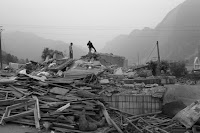DISCOVERY AND DISAPPOINTMENT
Paris can turn from a wintery -10° to a +10° Sometimes I think the + feels colder than the -. It was humid and dreary as I set out yesterday for the «Jeu de Paume» - one of the most important photographic museums in Paris.
Like many of us I had followed the Chinese Ai Weiwei work and wanted to see his first major exhibition in Paris, «Interlacing». Of course he was not there as still forbidden to leave the country. Once upon a time I was a frequent traveler to China so was even more interested to see what work he had done since he returned from the States in 1993 and ‘til 2011. His blog was shut down by authorities in 2009. Many of his photographs showed situations that were not appealing to politicians, not to mention many of his written statements on political issues.
There were not so many people when I arrived outside groups of Chinese. Two women asked the attendant how to pronounce Weiwei’s name, then stood in the middle of the first gallery and chatted about the food they were cooking this weekend. I have never quite understood why women chat in exhibitions about everything but what is to be seen front of them.
Al Weiwei deliberately confronts social conditions in China and other countries. I don’t know why. The photographs on a large scale left me totally cold. Practically as if they were «photo montage» and had little or nothing to do with reality. Yet his early photographs in black and white when he was in the USA and practically on the streets, were full of energy and from my point of view, here the misery was obvious. Over all I was disappointed in the exhibition.
The I went downstairs and discovered a photographer I do not know. Berenice Abbot (1898-1991). This too was a first in France and covered many different facets of the American photographer. a successful career as a portraitist and some of her photos were marvelous. Jean Cocteau, Eugene Atget (the French photographer noted for his photos on architecture and who had a great influence on her later work.)
Her documentation on New York is fascinating but what held my interest were her scientific photos. Her images on interference patterns, time exposure, magnetic fields were a bridge between science and modern image. They held my attention for a good 30 minutes.
I decided to buy a small book on her work and to show the photos to an Engineer friend in the evening. Hector is not in the least bit interested in art of any kind but when it comes to electricity and general engineering....I covered the short description of each photo. To my astonishment, he described exactly what each photo was and how it had been taken....
Like many of us I had followed the Chinese Ai Weiwei work and wanted to see his first major exhibition in Paris, «Interlacing». Of course he was not there as still forbidden to leave the country. Once upon a time I was a frequent traveler to China so was even more interested to see what work he had done since he returned from the States in 1993 and ‘til 2011. His blog was shut down by authorities in 2009. Many of his photographs showed situations that were not appealing to politicians, not to mention many of his written statements on political issues.
There were not so many people when I arrived outside groups of Chinese. Two women asked the attendant how to pronounce Weiwei’s name, then stood in the middle of the first gallery and chatted about the food they were cooking this weekend. I have never quite understood why women chat in exhibitions about everything but what is to be seen front of them.
Al Weiwei deliberately confronts social conditions in China and other countries. I don’t know why. The photographs on a large scale left me totally cold. Practically as if they were «photo montage» and had little or nothing to do with reality. Yet his early photographs in black and white when he was in the USA and practically on the streets, were full of energy and from my point of view, here the misery was obvious. Over all I was disappointed in the exhibition.
 |
| Sichuan earthquake 2008-2010 |
 |
| Fairytale portrait 2007 |
 |
| From blog photographs 2005-2009 |
The I went downstairs and discovered a photographer I do not know. Berenice Abbot (1898-1991). This too was a first in France and covered many different facets of the American photographer. a successful career as a portraitist and some of her photos were marvelous. Jean Cocteau, Eugene Atget (the French photographer noted for his photos on architecture and who had a great influence on her later work.)
 |
| Jean Cocteau 1927 |
 |
| Eugene Atget 1927 |
Her documentation on New York is fascinating but what held my interest were her scientific photos. Her images on interference patterns, time exposure, magnetic fields were a bridge between science and modern image. They held my attention for a good 30 minutes.
I decided to buy a small book on her work and to show the photos to an Engineer friend in the evening. Hector is not in the least bit interested in art of any kind but when it comes to electricity and general engineering....I covered the short description of each photo. To my astonishment, he described exactly what each photo was and how it had been taken....
 |
| Bouncing Ball Time exposure 1958-1961 |



Commentaires